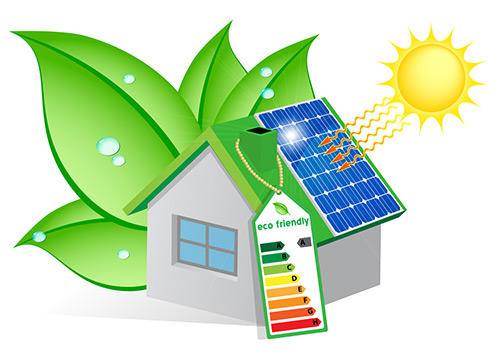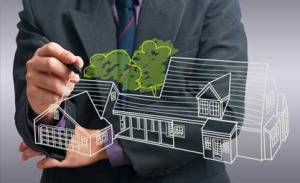Energy Efficient Technologies in Buildings
Green Building Construction also known as sustainable building is an energy efficient building technology that is founded on a plan that enhances the efficiency of saving not only energy but also building materials and water. Sustainable building helps to promote the well being of the residents by providing a healthy and safe living and working environment. Over the years, the construction of commercial buildings has had massive impact on the environment; it not requires large quantities of energy and resources but also leads to the production of dangerous atmospheric emissions that cause environmental pollution.
Owing to the increasing demand for buildings to accommodate the enormously growing businesses and population as well as having in mind the imminent risk of global warming, construction engineers and architect have come up with new building technologies that would render both residential and commercial buildings less harmful to the environment. As an energy efficient building technology, sustainable building has been instituted to solve major environmental problems (Johnsons Control, 2012).
Lately, several residential and commercial buildings have been switching to energy efficient technologies which according to Kibert (2008) are both cost efficient and save on the environment. Such technologies comprise of solar and wind energy among other sources of energy that will not destroy the environment. Statistics from a research carried out by Bauer (2009) on sustainable building revealed that commercial buildings are known to account for over 68% electricity consumption much of which is used to heat and ventilate a building. Furthermore, Bauer defines a sustainable building technology as the one that should several architectural and design strategies, which deal with the energy conservation in terms of air conditioning and cooling, ventilation as well as passive solar heating.
Global warming is a serious crisis that is greatly affecting the world. In order to reverse or end this menace, the society must take proactive measures, such as learning to adjust what they use in order to be less dangerous to the environment. Constructing “green” buildings would significantly solve this problem. There exists several ways of averting environmental degradation and additional ways are being embraced daily. As these fresh developments crop up, the returns associated with embracing green building becomes more evident and reasonable for the consumer (Projects by Students for Students, 2012).
Both fresh and innovative developments have been made in the engineering field with the aim of helping protect and save the environment. It is imperative for each and every person to be to be cognizant of energy consumption, owing to the detrimental effects of global warming. While the implementation green building construction may be associated with huge capital outlays, new construction developments have been linked to cost-effective solutions. Although green “engineering” and sustainable building has been on the media spotlight lately, the technology is however as old as civilization itself. Solar energy is definitely the most popular form of energy conservation.

Solar panels have been known to decrease the consumption of energy in several commercial buildings through the production of alternate energy from the sun. However, as ideal as the solar power might be, the technology is only restricted to places that receive direct sunlight every single day in a year. The Kurilpa Bridge at Brisbane provides a perfect example of how solar energy has been implemented to cut on cost and reduce pollution. Equipped with 85 solar panels, the sun is able to account for over 85 percent of the bridge’s energy needs as well as eliminate annual carbon emissions by over 39 tonnes (Esagawa, 2003).
Apart from the significant solar energy, other technologies that offer sustainable developments have been cropping up. For instance, wind is considered as a major source of energy. The major reason why wind turbines are being preferred is because it is an efficient and cleaner way of generating electricity. Actually wind turbines do not need any fossil fuels to produce any sort of electricity and is fully reliant on the wind. This guarantees that there are no carbon emissions. As the winner of the prestigious LEAF “Best use of Technology” award, the 240 meters tall Bahrain world trade center has beaten them all to be the best striking model for green building. The commercial building has massive wind turbines that generate electricity for the mega building. Definitely, Bahrain world trade center strikes out as the best environmental friendly building in the world.
In addition, the use natural light as an energy efficient technology has been greatly embraced by new large commercial buildings. Modern eco-friendly building is being designed with several windows and skylights so as to tap natural light deep into the structure. This saves on energy as artificial lights are made to turn off once there is sufficient amount of natural light. This technology has been implanted by the California Academy of Sciences at golden gate park in San Francisco. The corporate office at Luck Stone in Goochland is another building that has fully implemented the use of natural light. The building has several skylights and windows allow natural light.
Green Building Construction
Green and sustainable construction may be realized through the various choices of building material. While non-renewable materials rapidly deplete the environment, opting for renewable resources to build is significantly decreases the amount of pollution related to construction as well as slows the exhaustion of non-renewable resources. In addition, the use of renewable building materials is economically viable, environmental friendly and energy efficient. However, it would even be greener, not to cite cost-effective, to renovate an already existing building as opposed to constructing a new one. This would save the ecosystem by avoiding the production of all new materials (Kibert, 2008).
Despite the fact that most green engineering methods give back to the environment by lowering the amount of energy used, a number of techniques usually support the local habitat more directly. For instance, the use of green roofs is becoming more successful and efficient. A green roof is made up of a layer of soil and vegetation and is beneficial to the building in several ways. Most important is that the runoff water from the top of a green roof drains cleaner as compared to before it hit the roof.
Furthermore, green roofs provide great insulation by blocking out the scorching sun during the hot seasons such as summer, or preventing the heat from escaping the building in the winter. Since their inception more than five years ago, Green roofs been implemented in major large commercial buildings. For instance, Sun Trust Bank in Richmond transformed the top of a four-story building to a lovely 11,800-square-foot ‘green roof,’ complete with drought-resistant plants that absorb storm water and guzzle carbon dioxide (Bauer, 2003).
One technique that is still developing is the conservation of clean hot or cold air. The California Academy of Sciences building has vents that open on the domes to let out hot air as well as motorized windows to let in cool air. While this can control the temperature in a building efficiently, air quality is just as important, “since, on average, people spend 80-90% of their time in buildings” (Bauer, 2003). There is a constant battle between keeping a constant temperature while using the least amount of energy and keeping the air fresh. Most home heating and air conditioning systems advertise providing accurate temperature control as well as filtering mold, moisture, dust, and pollen. There is not yet technology that can meet the same standards while using much less energy.
Although present day practices in green building construction are important, the real success lies with the future. The future is what will transform the entire world into a place that is self-constructive, rather than destructive. Even more beneficial than new technologies arising is the improving of existing technologies to make them greener, more user friendly, and more cost efficient. Geothermal heating and cooling and water conservation techniques appear to be some technologies that will be making major steps to improvement in the near future.
Regulations influence people’s lives, whether those individuals desire to abide by them or not; however, is it feasible to be inspired sufficiently to a point where regulations are not required. This is a fact that engineers and investors argue over. There are not at present numerous compulsory laws and policies to guide people in green building structure, but the intensity are escalating. The verdict to make a structure “bright green” is frequently a responsibility of the engineers and architects of the structure. Occasionally, it may basically amount to paying additional finances for the structure upfront so as to publicize that a structure is “green,” but there are numerous unknown profits that can be disregarded at the outset (Kibert, 2008).
There are presently numerous structures of authorization in existence these days that support green building, and that is what the majority of them do– they support green building, as in opposition to authorizing it. The major one of these is the Leaders in Engineering and Environmental Development (LEED), qualifications. Numerous structures at present are determined to acquire one of the little types of LEED qualifications.
70% of latest LEED qualified structures fit into the latest building or main repairs group. With every range of qualifications, there come diverse stages: Certified, Silver, Gold, and Platinum. Each of the stages of qualifications would achieve the recognized structure recognition in addition to the evident ecological and financial payback. As declared on the LEED website, “LEED is a third-party qualifications curriculum and the nationwide acknowledged standard for the blueprint, construction and operation of high performance green buildings” (2008).
A LEED certification is broadly cherished, creating support and speeding up of the implementation of green structure methods. LEED ventures are endorsed by central and national public structures. There are as well LEED structures in 41 diverse nations (2008). The qualifications of a LEED qualification for a new structure are founded off of six groups: sustainable sites, water efficiency, energy and atmosphere, materials and resources, indoor environmental quality, and innovation and design process (Kibert, 2008).
Green building construction is quickly growing in both importance and popularity. There are several businesses that are taking benefiting out of this, whereas at the same time cheering for more change. These are the kind of companies that deal with green products, involve themselves in environmental activities, and encourage the consumer to go green. Uncertainly, it is evident that we must embrace change quickly so that we may avert the environmental catastrophe that is about to condemn our country.
Individuals will have to amend their way of life in order to overturn the damage that has already been done. Besides saving the environment, the emerging intelligence of green building construction and engineering will help consumers save money by cutting down the rate of energy consumption. As soon as fresh technologies are invented, there is a steady development of that technology until it has been perfected, making it inexpensive and user friendly. If people were to exploit these advances as they open up and are confirmed sustainable, at that moment they will be following the road that guides back to a healthy successful earth on top of money in their wallet.
References
Bauer, M. (2009). Green Building: A Book for Sustainable Architecture. London: Springer.
Esagawa, T. (2003). Environmentally Sustainable Buildings: Challenges and Policies. New York: OECD.
Kibert, C. (2008). Sustainable Construction: A Green Building Delivery and Design. New York: John Wiley and Sons.
Johnsons Controls. (2012). make you Buildings Work: More Efficiently, Sustainably and Profitably.
Projects by Students for Students. (2012). Energy Sources.


